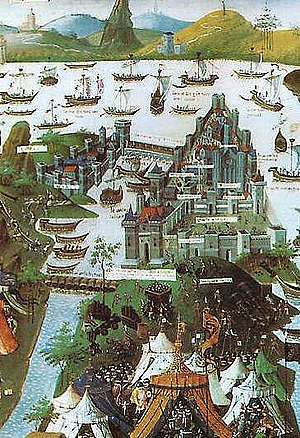Fall of Constantinople
The Fall of Constantinople (Greek: Ἅλωσις τῆς Κωνσταντινουπόλεως, Halōsis tēs Kōnstantinoupoleōs; Turkish: İstanbul'un Fethi Conquest of Istanbul) was the capture of the capital of the Byzantine Empire by an invading Ottoman army on 29 May 1453. The attackers were commanded by the 21-year-old Sultan Mehmed II, who defeated an army commanded by Emperor Constantine XI Palaiologos and took control of the imperial capital, ending a 53-day siege that began on 6 April 1453. After conquering the city, Sultan Mehmed transferred the capital of his Empire from Edirne to Constantinople, and established his court there.
The capture of the city (and two other Byzantine splinter territories soon thereafter) marked the end of the Byzantine Empire, a continuation of the Roman Empire, an imperial state dating to 27 BCE, which had lasted for nearly 1,500 years.[3] The conquest of Constantinople also dealt a massive blow to Christendom, as the Muslim Ottoman armies thereafter were left unchecked to advance into Europe without an adversary to their rear.
It was also a watershed moment in military history. Since ancient times, cities had used ramparts and city walls to protect themselves from invaders, and Constantinople's substantial fortifications had been a model followed by cities throughout the Mediterranean region and Europe. The Ottomans ultimately prevailed due to the use of gunpowder (which powered formidable cannons).[4]
The conquest of the city of Constantinople and the end of the Byzantine Empire[5] was a key event in the Late Middle Ages which also marks, for some historians, the end of the Medieval period.[6]
State of the Byzantine Empire
Constantinople had been an imperial capital since its consecration in 330 under Roman Emperor, Constantine the Great. In the following eleven centuries, the city had been besieged many times but was captured only once: during the Fourth Crusade in 1204.[7]:304 The crusaders established an unstable Latin state in and around Constantinople while the remaining empire splintered into a number of Byzantine successor states, notably Nicaea, Epirus and Trebizond. They fought as allies against the Latin establishments, but also fought among themselves for the Byzantine throne.
The Nicaeans eventually reconquered Constantinople from the Latins in 1261. Thereafter, there was little peace for the much-weakened empire as it fended off successive attacks by the Latins, the Serbians, the Bulgarians, and, most importantly, the Ottoman Turks.[7] [8][9][10] The Black Plague between 1346 and 1349 killed almost half of the inhabitants of Constantinople.[11] The city was severely depopulated due to the general economic and territorial decline of the empire, and by 1453 consisted of a series of walled villages separated by vast fields encircled by the fifth-century Theodosian walls.
By 1450 the empire was exhausted and had shrunk to a few square miles outside the city of Constantinople itself, the Princes' Islands in the Sea of Marmara, and the Peloponnese with its cultural center at Mystras. The Empire of Trebizond, an independent successor state that formed in the aftermath of the Fourth Crusade, also survived on the coast of the Black Sea.
Preparations
When Sultan Mehmed II succeeded his father in 1451, he was just nineteen years old. Many European courts assumed that the young Ottoman ruler would not seriously challenge Christian hegemony in the Balkans and the Aegean.[12] This calculation was boosted by Mehmed's friendly overtures to the European envoys at his new court.[13] But Mehmed's mild words were not matched by actions. By early 1452, work began on the construction of a second fortress (Rumeli hisarı) on the Bosphorus,[14] on the European side several miles north of Constantinople, set directly across the strait on the Asian side from the Anadolu Hisarı fortress, built by his great-grandfather Bayezid I. This pair of fortresses ensured complete control of sea traffic on the Bosphorus;[15] and defended against attack by the Genoese colonies on the Black Sea coast to the north. (This new fortress, was called Boğazkesen, which means 'strait-blocker' or 'throat-cutter', to emphasize its strategic position.) In October 1452, Mehmed ordered Turakhan Beg to station a large garrison force in the Peloponnese to block Thomas and Demetrios (despotes in Southern Greece) from providing aid to their brother Constantine XI Palaiologos during the impending siege of Constantinople.[nb 1] Michael Critobulus says about the speech of Mehmed II to his soldiers: "My friends and men of my empire! You all know very well that our forefathers secured this kingdom that we now hold at the cost of many struggles and very great dangers and that, having passed it along in succession from their fathers, from father to son, they handed it down to me. For some of the oldest of you were sharers in many of the exploits carried through by them—those at least of you who are of maturer years—and the younger of you have heard of these deeds from your fathers. They are not such very ancient events nor of such a sort as to be forgotten through the lapse of time. Still the eyewitness of those who have seen testifies better than does the hearing of deeds that happened but yesterday or the day before." Byzantine Emperor Constantine XI swiftly understood Mehmed's true intentions and turned to Western Europe for help; but now the price of centuries of war and enmity between the eastern and western churches had to be paid. Since the mutual excommunications of 1054, the Pope in Rome was committed to establishing authority over the eastern church. Nominal union had been negotiated in 1274, at the Second Council of Lyon, and indeed, some Palaiologoi emperors (Latin, Palaeologan) had since been received into the Latin church. Emperor John VIII Palaiologos had also recently negotiated union with Pope Eugene IV, with the Council of Florence of 1439 proclaiming a Bull of Union. These events, however, stimulated a propaganda initiative by anti-unionist Orthodox partisans in Constantinople; the population, as well as the laity and leadership of the Byzantine Church, became bitterly divided. Latent ethnic hatred between Greeks and Italians, stemming from the events of the Massacre of the Latins in 1182 by the Greeks and the sack of Constantinople in 1204 by the Latins, played a significant role. Finally, the attempted Union failed, greatly annoying Pope Nicholas V and the hierarchy of the Roman church.
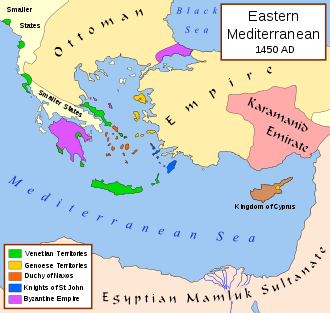
In the summer of 1452, when Rumelı Hisari was completed and the threat had become imminent, Constantine wrote to the Pope, promising to implement the Union, which was declared valid by a half-hearted imperial court on 12 December 1452.[7]:373 Although he was eager for an advantage, Pope Nicholas V did not have the influence the Byzantines thought he had over the Western kings and princes, some of whom were wary of increasing Papal control, and these had not the wherewithal to contribute to the effort, especially in light of the weakened state of France and England from the Hundred Years' War, Spain being in the final part of the Reconquista, the internecine fighting in the German Principalities, and Hungary and Poland's defeat at the Battle of Varna of 1444. Although some troops did arrive from the mercantile city states in the north of Italy, the Western contribution was not adequate to counterbalance Ottoman strength. Some Western individuals, however, came to help defend the city on their own account. Cardinal Isidore, funded by the pope, arrived in 1452 with 200 archers[17] One of these was an accomplished soldier from Genoa, Giovanni Giustiniani, who arrived with 400 men from Genoa and 300 men from Genoese Chios, in January 1453.[18]:83–84 As a specialist in defending walled cities, he was immediately given the overall command of the defense of the land walls by the emperor. Around the same time, the captains of the Venetian ships that happened to be present in the Golden Horn offered their services to the Emperor, barring contrary orders from Venice, and Pope Nicholas undertook to send three ships laden with provisions, which set sail near the end of March.[18]:81
In Venice, meanwhile, deliberations were taking place concerning the kind of assistance the Republic would lend to Constantinople. The Senate decided upon sending a fleet in February 1453, but there were delays, and when it finally set out late in April, it was already too late for it to be able to take part in the battle.[19][18]:85 Further undermining Byzantine morale, seven Italian ships with around 700 men slipped out of the capital at the moment when Giustiniani arrived, men who had sworn to defend the capital. At the same time, Constantine's attempts to appease the Sultan with gifts ended with the execution of the Emperor's ambassadors — even Byzantine diplomacy could not save the city.[7]:373
.jpg)
Fearing a possible naval attack along the shores of the Golden Horn, Emperor Constantine XI ordered that a defensive chain be placed at the mouth of the harbour. This chain, which floated on logs, was strong enough to prevent any Turkish ship from entering the harbour. This device was one of two that gave the Byzantines some hope of extending the siege until the possible arrival of foreign help.[19]:380 This strategy was enforced because in 1204 the armies of the Fourth Crusade successfully circumvented Constantinople's land defenses by breaching the Golden Horn Wall. Another strategy employed by the Byzantines was the repair and fortification of the Land Wall (Theodosian Walls). Emperor Constantine deemed it necessary to ensure that the Blachernae district's wall were the most fortified because that section of the wall protruded northwards. The land fortifications comprised a 60 ft (18 m) wide moat fronting inner and outer crenellated walls studded with towers every 45–55 metres.[20]
Strength
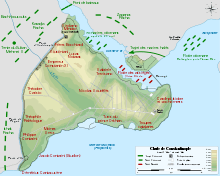
The army defending Constantinople was relatively small, totaling about 7,000 men, 2,000 of whom were foreigners.[nb 2] At the onset of the siege, probably fewer than 50,000 people were living within the walls, including the refugees from the surrounding area.[21]:32 [nb 3] Turkish commander Dorgano, who was in Constantinople in the pay of the Emperor, was also guarding one of the quarters of the city on the seaward side with the Turks in his pay. These Turks kept loyal to the Emperor and perished in the ensuing battle. The defending army's Genoese corps were well trained and equipped, while the rest of the army consisted of small numbers of well-trained soldiers, armed civilians, sailors and volunteer forces from foreign communities, and finally monks. The garrison used a few small-calibre artillery pieces, which nonetheless proved ineffective. The rest of the city repaired walls, stood guard on observation posts, collected and distributed food provisions, and collected gold and silver objects from churches to melt down into coins to pay the foreign soldiers.
The Ottomans had a much larger force. Recent studies and Ottoman archival data state that there were about 50,000–80,000 Ottoman soldiers including between 5,000 and 10,000 Janissaries,[22] *70 cannons[23]:139–140[21][24] an elite infantry corps, and thousands of Christian troops, notably 1,500 Serbian cavalry that the Serbian lord Đurađ Branković was forced to supply as part of his obligation to the Ottoman sultan—just a few months before, he had supplied the money for the reconstruction of the walls of Constantinople. Contemporaneous Western witnesses of the siege, who tend to exaggerate the military power of the Sultan, provide disparate and higher numbers ranging from 160,000 to 200,000 and to 300,000[22](Niccolò Barbaro: 160,000;[25] the Florentine merchant Jacopo Tedaldi[26] and the Great Logothete George Sphrantzes:[27] 200,000; the Cardinal Isidore of Kiev[28] and the Archbishop of Mytilene Leonardo di Chio:[29] 300,000).[30]
Ottoman dispositions and strategies
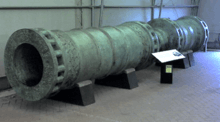
Mehmed built a fleet to besiege the city from the sea (partially manned by Greek sailors from Gallipoli).[21]Contemporary estimates of the strength of the Ottoman fleet span between about 110 ships (Tedaldi),[26] 145 (Barbaro),[25] 160 (Ubertino Pusculo),[31] 200–250 (Isidore of Kiev,[28] Leonardo di Chio[32]) to 430 (Sphrantzes).[27] A more realistic modern estimate predicts a fleet strength of 126 ships comprising 6 large galleys, 10 ordinary galleys, 15 smaller galleys, 75 large rowing boats, and 20 horse-transports.[21]:44
Before the siege of Constantinople, it was known that the Ottomans had the ability to cast medium-sized cannons, but the range of some pieces they were able to field far surpassed the defenders' expectations. Instrumental to this Ottoman advancement in arms production was a somewhat mysterious figure by the name of Orban (Urban), a Hungarian (though some suggest he was German).[7]:374 One cannon designed by Orban was named "Basilica" and was 27 feet (8.2 m) long, and able to hurl a 600 lb (272 kg) stone ball over a mile (1.6 km).[33]
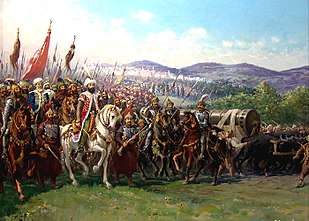
The master founder initially tried to sell his services to the Byzantines, who were unable to secure the funds needed to hire him. Orban then left Constantinople and approached Mehmed II, claiming that his weapon could blast 'the walls of Babylon itself'. Given abundant funds and materials, the Hungarian engineer built the gun within three months at Edirne, from which it was dragged by sixty oxen to Constantinople. In the meantime, Orban also produced other cannons for the Turkish siege forces.[18]:77–8
Orban's cannon had several drawbacks: it took three hours to reload; cannonballs were in very short supply; and the cannon is said to have collapsed under its own recoil after six weeks (this is disputed,[22] however, given that it was only reported in the letter of Archbishop Leonardo di Chio[29] and in the later and often unreliable Russian chronicle of Nestor Iskander).[nb 4] Having previously established a large foundry about 150 miles (240 km) away, Mehmed now had to undertake the painstaking process of transporting his massive artillery pieces. Orban's giant cannon was said to have been accompanied by a crew of 60 oxen and over 400 men.[7]:374
In preparation for the final assault, Mehmed had an artillery train of seventy large pieces dragged from his headquarters at Edirne, in addition to the bombards cast on the spot.[34]
Mehmed planned to attack the Theodosian Walls, the intricate series of walls and ditches protecting Constantinople from an attack from the West, the only part of the city not surrounded by water. His army encamped outside the city on the Monday after Easter, 2 April 1453.
The bulk of the Ottoman army were encamped south of the Golden Horn. The regular European troops, stretched out along the entire length of the walls, were commanded by Karadja Pasha. The regular troops from Anatolia under Ishak Pasha were stationed south of the Lycus down to the Sea of Marmara. Mehmed himself erected his red-and-gold tent near the Mesoteichion, where the guns and the elite regiments, the Janissaries, were positioned. The Bashi-bazouks were spread out behind the front lines. Other troops under Zagan Pasha were employed north of the Golden Horn. Communication was maintained by a road that had been constructed over the marshy head of the Horn.[18]:94–5
Byzantine dispositions and strategies

The city had about 20 km of walls (land walls: 5.5 km; sea walls along the Golden Horn: 7 km; sea walls along the Sea of Marmara: 7.5 km), one of the strongest sets of fortified walls in existence. The walls had recently been repaired (under John VIII) and were in fairly good shape, giving the defenders sufficient reason to believe that they could hold out until help from the West arrived.[21]:39 In addition, the defenders were relatively well-equipped with a fleet of 26 ships: 5 from Genoa, 5 from Venice, 3 from Venetian Crete, 1 from Ancona, 1 from Aragon, 1 from France, and about 10 Byzantine.[21]:45
On 5 April, the Sultan himself arrived with his last troops, and the defenders took up their positions. As their numbers were insufficient to occupy the walls in their entirety, it had been decided that only the outer walls would be manned. Constantine and his Greek troops guarded the Mesoteichion, the middle section of the land walls, where they were crossed by the river Lycus. This section was considered the weakest spot in the walls and an attack was feared here most. Giustiniani was stationed to the north of the emperor, at the Charisian Gate (Myriandrion); later during the siege, he was shifted to the Mesoteichion to join Constantine, leaving the Myriandrion to the charge of the Bocchiardi brothers. Minotto and his Venetians were stationed in the Blachernae palace, together with Teodoro Caristo, the Langasco brothers, and Archbishop Leonardo of Chios.[18] :92
To the left of the emperor, further south, were the commanders Cataneo, with Genoese troops, and Theophilus Palaeologus, who guarded the Pegae Gate with Greek soldiers. The section of the land walls from the Pegae Gate to the Golden Gate (itself guarded by a certain Genoese called Manuel) was defended by the Venetian Filippo Contarini, while Demetrius Cantacuzenus had taken position on the southernmost part of the Theodosian wall.[18] :92
The sea walls were manned more sparsely, with Jacobo Contarini at Stoudion, a makeshift defense force of Greek monks to his left hand, and prince Orhan at the Harbour of Eleutherius. Pere Julià was stationed at the Great Palace with Genoese and Catalan troops; Cardinal Isidore of Kiev guarded the tip of the peninsula near the boom. The sea walls at the southern shore of the Golden Horn were defended by Venetian and Genoese sailors under Gabriele Trevisano.[18] :93
Two tactical reserves were kept behind in the city, one in the Petra district just behind the land walls and one near the Church of the Holy Apostles, under the command of Loukas Notaras and Nicephorus Palaeologus, respectively. The Venetian Alviso Diedo commanded the ships in the harbor.[18] :94
Although the Byzantines also had cannons, they were much smaller than those of the Ottomans and the recoil tended to damage their own walls.[29]
According to David Nicolle, despite many odds, the idea that Constantinople was inevitably doomed is wrong, and the overall situation was not as one-sided as a simple glance at a map might suggest.[21]:40It has also been claimed that Constantinople was "the best-defended city in Europe" at that time.[35]
Siege
At the beginning of the siege, Mehmed sent out some of his best troops to reduce the remaining Byzantine strongholds outside the city of Constantinople. The fortress of Therapia on the Bosphorus and a smaller castle at the village of Studius near the Sea of Marmara were taken within a few days. The Princes' Islands in the Sea of Marmara were taken by Admiral Baltoghlu's fleet.[18]:96–7 Mehmed's massive cannon fired on the walls for weeks, but due to its imprecision and extremely slow rate of reloading the Byzantines were able to repair most of the damage after each shot, limiting the cannon's effect.[7]:376
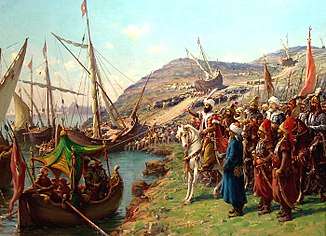
Meanwhile, despite some probing attacks, the Ottoman fleet under Suleiman Baltoghlu could not enter the Golden Horn due to the chain the Byzantines had previously stretched across the entrance. Although one of the fleet's main tasks was to prevent any ships from outside from entering the Golden Horn, on 20 April a small flotilla of four Christian ships[nb 5] managed to slip in after some heavy fighting, an event which strengthened the morale of the defenders and caused embarrassment to the Sultan.[7]:376 Baltoghlu's life was spared after his subordinates testified to his bravery during the conflict.
Mehmed ordered the construction of a road of greased logs across Galata on the north side of the Golden Horn, and dragged his ships over the hill, directly into the Golden Horn on 22 April, bypassing the chain barrier.[7]:376 This seriously threatened the flow of supplies from Genoese ships from the — nominally neutral — colony of Pera, and demoralized the Byzantine defenders. On the night of 28 April, an attempt was made to destroy the Ottoman ships already in the Golden Horn using fire ships, but the Ottomans had been warned in advance and forced the Christians to retreat with heavy losses. Forty Italians escaped their sinking ships and swam to the northern shore. On orders of Mehmed, they were impaled on stakes, in sight of the city's defenders on the sea walls across the Golden Horn. In retaliation, the defenders brought their Ottoman prisoners, 260 in all, to the walls, where they were executed, one by one, before the eyes of the Ottomans.[18]:108[36] With the failure of their attack on the Ottoman vessels, the defenders were forced to disperse part of their forces to defend the sea walls along the Golden Horn.
The Ottoman army had made several frontal assaults on the land wall of Constantinople, but were always repelled with heavy losses.[37] Venetian surgeon Niccolò Barbaro, describing in his diary one of such frequent land attacks especially by the Janissaries, wrote:
| “ | They found the Turks coming right up under the walls and seeking battle, particularly the Janissaries ... and when one or two of them were killed, at once more Turks came and took away the dead ones ... without caring how near they came to the city walls. Our men shot at them with guns and crossbows, aiming at the Turk who was carrying away his dead countryman, and both of them would fall to the ground dead, and then there came other Turks and took them away, none fearing death, but being willing to let ten of themselves be killed rather than suffer the shame of leaving a single Turkish corpse by the walls.[25] | ” |

After these inconclusive frontal offensives, the Ottomans sought to break through the walls by constructing underground tunnels in an effort to mine them from mid-May to 25 May. Many of the sappers were miners of Serbian origin sent from Novo Brdo by the Serbian despot. They were placed under the command of Zagan Pasha. However, an engineer named Johannes Grant, a German[nb 6] who came together with the Genoese contingent, had counter-mines dug, allowing Byzantine troops to enter the mines and kill the workers. The Byzantines intercepted the first Serbian tunnel on the night of 16 May. Subsequent tunnels were interrupted on 21, 23, and 25 May, and destroyed with Greek fire and vigorous combat. On 23 May, the Byzantines captured and tortured two Turkish officers, who revealed the location of all the Turkish tunnels, which were then destroyed.[39]
On 21 May, Mehmed sent an ambassador to Constantinople and offered to lift the siege if they gave him the city. He promised he would allow the Emperor and any other inhabitants to leave with their possessions. Moreover, he would recognize the Emperor as governor of the Peloponnese. Lastly, he guaranteed the safety of the population that might choose to remain in the city. Constantine XI only agreed to pay higher tributes to the sultan and recognized the status of all the conquered castles and lands in the hands of the Turks as Ottoman possession.
| “ | Giving you though the city depends neither on me nor on anyone else among its inhabitants; as we have all decided to die with our own free will and we shall not consider our lives.[nb 7] | ” |
Around this time, Mehmed had a final council with his senior officers. Here he encountered some resistance; one of his Viziers, the veteran Halil Pasha, who had always disapproved of Mehmed's plans to conquer the city, now admonished him to abandon the siege in the face of recent adversity. Zagan Pasha argued against Halil Pasha, and insisted on an immediate attack. Mehmed planned to overpower the walls by sheer force, expecting that the weakened Byzantine defense by the prolonged siege would now be worn out before he ran out of troops and started preparations for a final all-out offensive.
Final assault
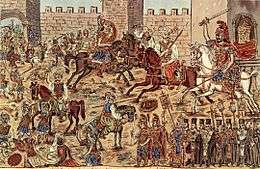
Preparations for the final assault were started in the evening of 26 May and continued to the next day.[7]:378 For 36 hours after the war council decision to attack, the Ottomans extensively mobilized their manpower in order to prepare for the general offensive.[7]:378 Prayer and resting would be then granted to the soldiers on the 28th, and then the final assault would be launched. On the Byzantine side, a small Venetian fleet of 12 ships, after having searched the Aegean, reached the Capital on May 27 and reported to the Emperor that no large Venetian relief fleet was on its way.[7]:377 On May 28, as the Ottoman army prepared for the final assault, large-scale religious processions were held in the city. In the evening a last solemn ceremony was held in the Hagia Sophia, in which the Emperor and representatives of both the Latin and Greek church partook, together with nobility from both sides.[41]:651–2
Shortly after midnight on May 29 the all-out offensive began. The Christian troops of the Ottoman Empire attacked first, followed by the successive waves of the irregular azaps, who were poorly trained and equipped, and Anatolians who focused on a section of the Blachernae walls in the northwest part of the city, which had been damaged by the cannon. This section of the walls had been built earlier, in the eleventh century, and was much weaker. The Anatolians managed to breach this section of walls and entered the city but were just as quickly pushed back by the defenders. Finally, as the battle was continuing, the last wave, consisting of elite Janissaries, attacked the city walls. The Genoese general in charge of the land troops,[22][28][29] Giovanni Giustiniani, was grievously wounded during the attack, and his evacuation from the ramparts caused a panic in the ranks of the defenders.[nb 8]

With Giustiniani's Genoese troops retreating into the city and towards the harbor, Constantine and his men, now left to their own devices, kept fighting and managed to successfully hold off the Janissaries for a while, but eventually they could not stop them from entering the city. The defenders were also being overwhelmed at several points in Constantine's section. When Turkish flags were seen flying above a small postern gate, the Kerkoporta, which was left open, panic ensued, and the defense collapsed, as Janissary soldiers, led by Ulubatlı Hasan pressed forward. Many Greek soldiers ran back home to protect their families, the Venetians ran over to their ships, and a few of the Genoese got over to Galata. The rest committed suicide by jumping off the city walls or surrendered.[19] The Greek houses nearest to the walls were the first to suffer from the Ottomans. It is said that Constantine, throwing aside his purple regalia, led the final charge against the incoming Ottomans, perishing in the ensuing battle in the streets just like his soldiers. On the other hand, Nicolò Barbaro, a Venetian eyewitness to the siege, wrote in his diary that it was said that Constantine hanged himself at the moment when the Turks broke in at the San Romano gate, although his ultimate fate remains unknown.[nb 9]
After the initial assault, the Ottoman Army fanned out along the main thoroughfare of the city, the Mese, past the great forums, and past the Church of the Holy Apostles, which Mehmed II wanted to provide a seat for his newly appointed patriarch which would help him better control his Christian subjects. Mehmed II had sent an advance guard to protect key buildings such as the Church of the Holy Apostles.
A small few lucky civilians managed to escape. When the Venetians retreated over to their ships, the Ottomans had already taken the walls of the Golden Horn. Luckily for the occupants of the city, the Ottomans were not interested in killing them, but rather in the loot they could get from raiding the city's houses, so they decided to attack the city instead. The Venetian captain ordered his men to break open the gate of the Golden Horn. Having done so, the Venetians left in ships filled with soldiers and refugees. Shortly after the Venetians left, a few Genoese ships and even the Emperor's ships followed them out of the Golden Horn. This fleet narrowly escaped prior to the Ottoman navy assuming control over the Golden Horn, which was accomplished by midday.[19] The Army converged upon the Augusteum, the vast square that fronted the great church of Hagia Sophia whose bronze gates were barred by a huge throng of civilians inside the building, hoping for divine protection. After the doors were breached, the troops separated the congregation according to what price they might bring in the slave markets.
Ottoman casualties are unknown but they are believed by most historians to be very heavy due to several unsuccessful Ottoman attacks made during the siege and final assault. Barbaro described blood flowing in the city "like rainwater in the gutters after a sudden storm", and bodies of the Turks and Christians floating in the sea "like melons along a canal".[25]
Plundering phase
Mehmed II had promised to his soldiers three days to plunder the city, to which they were entitled.[18]:145[43] Soldiers fought over the possession of some of the spoils of war.[44]:283 According to the Venetian surgeon Nicolò Barbaro "all through the day the Turks made a great slaughter of Christians through the city". According to Philip Mansel, widespread persecution of the city's civilian inhabitants took place, resulting in thousands of murders and rapes and 30,000 civilians being enslaved or forcibly deported.[45]
The looting was extremely thorough in certain parts of the city. Weeks later on 2 June, the Sultan would find the city largely deserted and half in ruins; churches had been desecrated and stripped, houses were no longer habitable and stores and shops were emptied. He is famously reported to have been moved to tears by this, speaking "What a city we have given over to plunder and destruction."[18]:152
Aftermath
On the third day of the conquest, Mehmed II ordered all looting to stop and issued a proclamation that all Christians who had avoided capture or who had been ransomed could return to their homes without further molestation, although many had no homes to return to, and many more had been taken captive and not ransomed.[18]:150–51 Byzantine historian George Sphrantzes, an eyewitness to the fall of Constantinople, described the Sultan's actions:[46][47]
| “ | On the third day after the fall of our city, the Sultan celebrated his victory with a great, joyful triumph. He issued a proclamation: the citizens of all ages who had managed to escape detection were to leave their hiding places throughout the city and come out into the open, as they were to remain free and no question would be asked. He further declared the restoration of houses and property to those who had abandoned our city before the siege. If they returned home, they would be treated according to their rank and religion, as if nothing had changed. | ” |
The Hagia Sophia was converted into a mosque, but the Greek Orthodox Church was allowed to remain intact and Gennadius Scholarius was appointed Patriarch of Constantinople. This was once thought to be the origin of the Ottoman millet system, however, it is now considered a myth and no such system existed in the fifteenth century.[48][49]
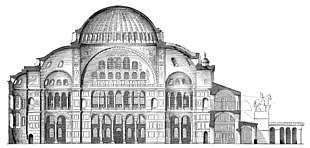
After the sack, many feared other European Christian kingdoms would suffer the same fate as Constantinople. Two possible responses emerged amongst the humanists and churchmen of that era: Crusade or dialogue. Pope Pius II strongly advocated for another Crusade, while Nicholas of Cusa supported engaging in a dialogue with the Ottomans.[50]
The Morean (Peloponnesian) fortress of Mystras, where Constantine's brothers Thomas and Demetrius ruled, constantly in conflict with each other and knowing that Mehmed would eventually invade them as well, held out until 1460. Long before the fall of Constantinople, Demetrius had fought for the throne with Thomas, Constantine, and their other brothers John and Theodore.[51]:446Thomas escaped to Rome when the Ottomans invaded Morea while Demetrius expected to rule a puppet state, but instead was imprisoned and remained there for the rest of his life. In Rome, Thomas and his family received some monetary support from the Pope and other Western rulers as Byzantine emperor in exile, until 1503. In 1461 the independent Byzantine state in Trebizond fell to Mehmed.[51]:446
Constantine XI had died without producing an heir, and had Constantinople not fallen he likely would have been succeeded by the sons of his deceased elder brother, who were taken into the palace service of Mehmed after the fall of Constantinople. The oldest boy, renamed to Murad, became a personal favorite of Mehmed and served as Beylerbey (Governor-General) of Rumeli (the Balkans). The younger son, renamed Mesih Pasha, became Admiral of the Ottoman fleet and Sancak Beg (Governor) of the Province of Gallipoli. He eventually served twice as Grand Vizier under Mehmed's son, Bayezid II.[52]
With the capture of Constantinople, Mehmed II had acquired the "natural" capital of its kingdom, albeit one in decline due to years of war. The loss of the city was a crippling blow to Christendom, and it exposed the Christian west to a vigorous and aggressive foe in the east. The Christian re-conquest of Constantinople remained a goal in Western Europe for many years after its fall to the House of Osman. Rumors of Constantine XI's survival and subsequent rescue by an angel led many to hope that the city would one day return to Christian hands. Pope Nicholas V called for an immediate counter-attack in the form of a crusade. When no European monarch was willing to lead the crusade, the Pope himself decided to go, but his early death stopped this plan. As Western Europe entered the 16th century, the age of Crusading began to come to an end.
For some time Greek scholars had gone to Italian city-states, a cultural exchange begun in 1396 by Coluccio Salutati, chancellor of Florence, who had invited Manuel Chrysoloras, a Byzantine scholar to lecture at the University of Florence.[53] After the conquest many Greeks, such as John Argyropoulos and Constantine Lascaris, fled the city and found refuge in the Latin West, bringing with them knowledge and documents from the Greco-Roman tradition to Italy and other regions that further propelled the Renaissance.[54][55] Those Greeks who stayed behind in Constantinople mostly lived in the Phanar and Galata districts of the city. The Phanariotes, as they were called, provided many capable advisers to the Ottoman rulers.
Third Rome
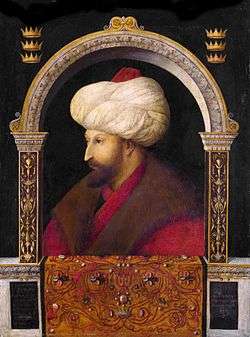
Byzantium is a term used by modern historians to refer to the later Roman Empire. In its own time, the Empire ruled from Constantinople (or "New Rome" as some people call it, although this was a laudatory expression that was never an official title) was considered simply as "the Roman Empire." The fall of Constantinople led competing factions to lay claim to being the inheritors of the Imperial mantle. Russian claims to Byzantine heritage clashed with those of the Ottoman Empire's own claim. In Mehmed's view, he was the successor to the Roman Emperor, declaring himself Kayser-i Rum, literally "Caesar of Rome", that is, of the Roman Empire, though he was remembered as "the Conqueror". He founded a political system that survived until 1922 with the establishment of the Republic of Turkey.
Stefan Dušan, Tsar of Serbia, and Ivan Alexander, Tsar of Bulgaria both made similar claims, regarding themselves as legitimate heirs to the Roman Empire. Other potential claimants, such as the Republic of Venice and the Holy Roman Empire have disintegrated into history.[56]
Impact on the Churches
In 17th-century Russia, the fall of Constantinople had a role in the fierce theological and political controversy between adherents and opponents of the reforms in the Russian Orthodox Church carried out by Patriarch Nikon, which he intended to bring the Russian Church closer to the norms and practices of other Orthodox churches. Avvakum and other "Old Believers" saw these reforms as a corruption of the Russian Church, which they considered to be the "true" Church of God. As the other Churches were more closely related to Constantinople in their liturgies, Avvakum argued that Constantinople fell to the Turks because of these heretical beliefs and practices.
The fall of Constantinople has a profound impact on the ancient Pentarchy of the Orthodox Church. Today, the four ancient sees of Jerusalem, Antioch, Alexandria, and Constantinople are almost completely devoid of followers and believers because of Islamization and the Dhimma system to which Christians have been subjected since the earliest days of Islam. As a result of this process, the center of authority in the Orthodox Church changed and migrated to Eastern Europe (e.g., Russia) rather than remaining in the former Byzantine Middle East.
Cultural references
Legends
There are many legends in Greece surrounding the Fall of Constantinople. It was said that the partial lunar eclipse that occurred on 22 May 1453 represented a fulfillment of a prophecy of the city's demise.[57] Four days later, the whole city was blotted out by a thick fog, a condition unknown in that part of the world in May. When the fog lifted that evening, a strange light was seen playing about the dome of the Hagia Sophia, which some interpreted as the Holy Spirit departing from the city. "This evidently indicated the departure of the Divine Presence, and its leaving the City in total abandonment and desertion, for the Divinity conceals itself in cloud and appears and again disappears." [58] For others, there was still a distant hope that the lights were the campfires of the troops of John Hunyadi who had come to relieve the city.[nb 10]
Another legend holds that two priests saying divine liturgy over the crowd disappeared into the cathedral's walls as the first Turkish soldiers entered. According to the legend, the priests will appear again on the day that Constantinople returns to Christian hands.[18]:147 Another legend refers to the Marble King (Constantine XI), holding that an angel rescued the emperor when the Ottomans entered the city, turning him into marble and placing him in a cave under the earth near the Golden Gate, where he waits to be brought to life again (a variant of the sleeping hero legend).[60][61]
Cultural impact
Guillaume Dufay composed several songs lamenting the fall of the Eastern church, and the duke of Burgundy, Philip the Good, avowed to take up arms against the Turks. However, as the growing Ottoman power from this date on coincided with the Protestant Reformation and subsequent Counter-Reformation, the recapture of Constantinople became an ever-distant dream. Even France, once a fervent participant in the Crusades, became an ally of the Ottomans.
Nonetheless, depictions of Christian coalitions taking the city and of the late Emperor's resurrection by Leo the Wise persisted.[10]:280
Impact on the Renaissance
The migration waves of Byzantine scholars and émigrés in the period following the sacking of Constantinople and the fall of Constantinople in 1453 is considered by many scholars key to the revival of Greek and Roman studies that led to the development of the Renaissance humanism[55] and science. These émigrés were grammarians, humanists, poets, writers, printers, lecturers, musicians, astronomers, architects, academics, artists, scribes, philosophers, scientists, politicians and theologians.[62] They brought to Western Europe the far greater preserved and accumulated knowledge of their own (Greek) civilization.
Megali idea
Between 1919 and 1922, Greek politician Eleftherios Venizelos attempted to implement the Megali Idea (recapture of Constantinople from the Ottoman Empire) in the Greco-Turkish War (1919–1922) since the Ottoman Empire was severely weakened by its defeat in World War I and by the occupation of Constantinople by the British and French. However, in the course of the war Venizelos lost the election of 1920 and went into exile and Greece was defeated in the war by Turkey.
Renaming of the city
Ottomans used the Arabic transliteration of the city's name "Kostantiniyye," (القسطنطينية), as can be seen in numerous Ottoman documents. Islambol (اسلامبول, Full of Islam) or Islambul (find Islam) or Islam(b)ol (old Turkic: be Islam), both in Turkish Language, were folk-etymological adaptations of Istanbul created after the Ottoman conquest of 1453 to express the city's new role as the capital of the Islamic Ottoman Empire. It is first attested shortly after the conquest, and its invention was ascribed by some contemporary writers to Sultan Mehmed II himself.[63]
The name of Istanbul is thought to be derived from the Greek phrase īs tīmbolī(n) (Greek: εἰς τὴν πόλιν, translit. eis tēn pólin, "to the City"), and it is claimed that it had already spread among the Turkish populace of the Ottoman Empire before the conquest. However, Istanbul only became the official name of the city in 1930 by the revised Turkish Postal Law as part of Atatürk's reforms.[64][65][66]
In historical fiction
- Lew Wallace, The Prince of India; or, Why Constantinople Fell. New York: Harper & Brothers Publishers, 1893. 2 volumes
- Mika Waltari, The Dark Angel (Original title Johannes Angelos) 1952. Translated from the Finnish by Naomi Walford and pub. in English edition, New York: Putnam, 1953
- Muharem Bazdulj, "The Bridge on Land" from The Second Book, 2000. Translated from Bosnian by Oleg Andric and Andrew Wachtel and pub. in English edition, Evanston: Northwestern University Press, 2005
- Andrew Novo, Queen of Cities, Seattle: Coffeetown Press, 2009
- Jack Hight, Siege. London: John Murray Publisher Ltd, 2010
- James Shipman, "Constantinopolis", Amazon Digital Services, 2013
- C.C. Humphreys, A Place called Armageddon. London: Orion, 2011
- Emanuele Rizzardi, L'ultimo Paleologo. PubMe Editore, 2017
- John Bellairs, "The Trolley to Yesterday" Dial, 1989
- Kiersten White, "The Conqueror's Saga", 2016
- Stefan Zweig, "Die Eroberung von Byzanz (Conquest of Byzantium)" in "Sternstunden der Menschheit (Decisive Moments in History)", 1927
See also
- Fetih 1453
- "How many angels can dance on the head of a pin?", question linked to the imagery of pointless debate while the city was falling.
- Military of the Ottoman Empire
- Tursun Beg (Turkish historian)
- Ulubatlı Hasan
- Dolfin Dolfin, venetian, naval commander during the siege
Notes
- ↑ While Mehmed II had been steadily preparing for the siege of Constantinople, he had sent the old general Turakhan and the latter's two sons, Ahmed Beg and Omar Beg, to invade the Morea and to remain there all winter also to prevent the despots Thomas and Demetrius from giving aid to Constantine XI.[16]:146
- ↑ According to Sphrantzes, whom Constantine had ordered to make a census, the Emperor was appalled when the number of native men capable of bearing arms turned out to be only 4,983. Leonardo di Chio gave a number of 6,000 Greeks.[18]:85
- ↑ The Spanish Cristóbal de Villalón claims there were ' 60,000 Turkish households, 40,000 Greek and Armenian, 10,000 Jewish.[18]:85
- ↑ Another expert who was employed by the Ottomans was Ciriaco de' Pizzicolli, also known as Ciriaco of Ancona, a traveler and collector of antiquities.
- ↑ These were the three Genoese ships sent by the Pope, joined by a large Imperial transport ship which had been sent on a foraging mission to Sicily previous to the siege and was on its way back to Constantinople.[18]:100
- ↑ Runciman speculates that he may have been Scottish[18]:84
- ↑ Original text: Τὸ δὲ τὴν πόλιν σοῖ δοῦναι οὔτ' ἐμὸν ἐστίν οὔτ' ἄλλου τῶν κατοικούντων ἐν ταύτῃ• κοινῇ γὰρ γνώμῃ πάντες αὐτοπροαιρέτως ἀποθανοῦμεν καὶ οὐ φεισόμεθα τῆς ζωῆς ἡμῶν.[40]
- ↑ Sources hostile towards the Genoese (such as the Venetian Nicolò Barbaro), however, report that Longo was only lightly wounded or not wounded at all, but, overwhelmed by fear, simulated the wound to abandon the battlefield, determining the fall of the city. These charges of cowardice and treason were so widespread that the Republic of Genoa had to deny them by sending diplomatic letters to the Chancelleries of England, France, the Duchy of Burgundy and others.[42]:296–97 Giustiniani was carried to Chios, where he succumbed to his wounds a few days later.
- ↑ Barbaro added the description of the emperor's heroic last moments to his diary based on information he received afterward. According to some Ottoman sources Constantine was killed in an accidental encounter with Turkish marines a little further to the south, presumably while making his way to the Sea of Marmara in order to escape by sea.[21]
- ↑ It is possible that all these phenomena were local effects of the cataclysmic Kuwae volcanic eruption in the Pacific Ocean. The "fire" seen may have been an optical illusion due to the reflection of intensely red twilight glow by clouds of volcanic ash high in the atmosphere.[59]
References
- ↑ "Exaggerated" western estimates ranged between 160,000 and 300,000.
- ↑ "İstanbul'un fethinde 600 Türk askeri, Fatih'e karşı savaştı" [In the Conquest of Istanbul 600 Turkish Military Fought Against the Conqueror]. Osmanlı Arauştırmalarlı (in Turkish).
- ↑ Momigliano & Schiavone (1997), Introduction ("La Storia di Roma"), p. XXI
- ↑ "The fall of Constantinople". The Economist. 23 December 1999. Retrieved 7 June 2017.
- ↑ Frantzes, Georgios; Melisseidis (Melisseides), Ioannis (Ioannes) A.; Zavolea-Melissidi, Pulcheria (2004). Εάλω η ΠόλιςΤ•ο χρονικό της άλωσης της Κωνσταντινούπολης: Συνοπτική ιστορία των γεγονότων στην Κωνσταντινούπολη κατά την περίοδο 1440 – 1453 [The City has Fallen: Chronicle of the Fall of Constantinople: Concise History of Events in Constantinople in the Period 1440–1453] (in Greek) (5 ed.). Athens: Vergina Asimakopouli Bros. ISBN 9607171918.
- ↑ Foster, Charles (22 September 2006). "The Conquest of Constantinople and the end of empire". Contemporary Review. Archived from the original on 11 June 2009.
It is the end of the Middle Ages
) - 1 2 3 4 5 6 7 8 9 10 11 12 Norwich, John Julius (1997). A Short History of Byzantium. New York: Vintage Books.
- ↑ Madden, Thomas (2005). Crusades: The Illustrated History. Ann Arbor: University of Michigan.
- ↑ Haldon, John (2000). Byzantium at War 600 – 1453. New York: Osprey.
- 1 2 Mango, Cyril (2002). The Oxford History of Byzantium. New York: Oxford University Press.
- ↑ "The Black Death". Archived from the original on 25 June 2008. Retrieved 13 August 2008. , Channel 4 – History.
- ↑ Runciman Fall. p.60
- ↑ Norwich Short Byz. Hist. p.373
- ↑ "Bosphorus (i.e. Bosporus), View from Kuleli, Constantinople, Turkey". World Digital Library. 1890–1900. Retrieved 2013-10-20.
- ↑ name="norwichshortbyzhist"/>:373
- ↑ Setton, Kenneth M. (1978). The Papacy and the Levant (1204–1571): The Fifteenth Century. 2. DIANE Publishing. ISBN 0-87169-127-2.
- ↑ Crowley, Roger (2013-02-12). 1453: The Holy War for Constantinople and the Clash of Islam and the West. Hachette Books. ISBN 978-1-4013-0558-1.
- 1 2 3 4 5 6 7 8 9 10 11 12 13 14 15 16 17 18 19 Runciman, Steven (1965). The Fall of Constantinople, 1453 (Canto ed.). Cambridge: Cambridge University Press. ISBN 9780521398329.
- 1 2 3 4 Nicol, Donald M. (1993). The Last Centuries of Byzantium, 1261–1453 (2nd ed.). Cambridge: Cambridge University Press.
- ↑ Michael Spilling, ed., Battles That Changed History: Key Battles That Decided the Fate of Nations ( London, Amber Books Ltd. 2010) p.187.
- 1 2 3 4 5 6 7 8 Nicolle, David (2000). Constantinople 1453: The End of Byzantium (Campaign). 78. Oxford: Osprey Publishing. ISBN 1-84176-091-9.
- 1 2 3 4 Pertusi, Agostino, ed. (1976). La Caduta di Costantinopoli, I: Le testimonianze dei contemporanei scrittori greci e latini [The Fall of Constantinople, I: The Testimony of the Contemporary Greek and Latin Writers] (in Italian). I. Verona: Fondazione Lorenzo Valla.
- ↑ Lanning, Michael Lee (2005). The Battle 100: The Stories Behind History's Most Influential Battles. Sourcebooks, Inc. ISBN 1-4022-2475-3.
- ↑ İnalcıkt, Halil (2001). Osmanlı İmparatorluğu Klasik Çağ (1300–1600) [The Ottoman Empire, The Classical Age, 1300–1600]. Translated by Itzkouritz, Norman; Imber, Colin. London: Orion.
- 1 2 3 4 Nicolò Barbaro, Giornale dell'Assedio di Costantinopoli, 1453. The autograph copy is conserved in the Biblioteca Marciana in Venice. Barbaro's diary has been translated into English by John Melville-Jones (New York:Exposition Press, 1969)
- 1 2 (in French) Concasty, M.-L., Les «Informations» de Jacques Tedaldi sur le siège et la prise de Constantinople
- 1 2 Sphrantzes, George. Οικτρός Γεώργιος ο Φραντζής ο και Πρωτοβεσιαρίτης Γρηγόριος τάχα μοναχός ταύτα έγραψεν υπέρ των καθ' αυτών και τινων μερικών γεγονότων εν τώ της αθλίας ζωής αυτε χρόνω [The Pitiful George Frantzes Who was Protovestiaros, Now a Monk, Wrote This for the Βetterment of Others and as Recompense for Some Deeds in His Miserable Life, This Chronicle] (in Greek).
- 1 2 3 Rutheniae, Isidorus (6 July 1453). "Isidore of Ruthenia" (Letter) (in Latin). Letter to Bisarion.
- 1 2 3 4 (in Latin) Leonardo di Chio, Letter to Pope Nicholas V, dated 16 August 1453, edited by J.-P. Migne, Patrologia Graeca, 159, 923A–944B.
- ↑ Leonardo di Chio, Letter,927B: "three hundred thousand and more".
- ↑ Ubertino Pusculo, Constantinopolis, 1464
- ↑ Leonardo di Chio, Letter, 930C.
- ↑ Davis, Paul (1999). 100 Decisive Battles. Oxford. p. 166. ISBN 978-0-19-514366-9.
- ↑ Arnold (2001) p. 111
- ↑ "The fall of Constantinople". The Economist. 23 December 1999.
- ↑ Crowley (2005), pp. 150–54
- ↑ Marios Philippides and Walter K. Hanak, The Siege and the Fall of Constantinople in 1453, (Ashgate Publishing, 2011), 520.
- ↑ From Jean Chartier, Chronicle of Charles VII, king of France, MS Bnf Français 2691, f. 246v
- ↑ Crowley, Roger. 1453: the holy war for Constantinople and the clash of Islam and the West. New York: Hyperion, 2005. pp. 168–171. ISBN 1-4013-0850-3.
- ↑ "29 Μαϊου 1453: Όταν «η Πόλις εάλω..." [29 May 1453: When the City Fell...]. "iefemerida.com" (in Greek). 29 May 2012. Retrieved 5 June 2017.
- ↑
- ↑ Desimoni, C. (1874). Adamo di Montaldo. Atti della Società Ligure di Storia Patria (Proceedings of the Ligurian Society for Homeland History) (in Italian). X. Genoa.
- ↑ Smith, Michael Llewellyn, The Fall of Constantinople, History Makers magazine No. 5, Marshall Cavendish, Sidgwick & Jackson (London).
- ↑ Reinert, Stephen (2002). The Oxford History of Byzantium. New York: Oxford UP.
- ↑ Mansel, Philip (1995). Constantinople: City of the World's Desire. Hachette UK. p. 79. ISBN 0-7195-5076-9.
- ↑ George Sphrantzes. The Fall of the Byzantine Empire: A Chronicle by George Sphrantzes 1401–1477. Translated by Marios Philippides. University of Massachusetts Press, 1980. ISBN 978-0-87023-290-9.
- ↑ Kritovoulos (or Kritoboulos). History of Mehmed the Conqueror. Translated by Charles T. Riggs. Greenwood Press Reprint, 1970. ISBN 978-0-8371-3119-1.
- ↑ Braude, Benjamin (1982). "Foundation Myths of the Millet System". In Braude, Benjamin; Bernard Lewis. Christians and Jews in the Ottoman Empire. 1. New York: Holmes & Meier. pp. 69–90. ISBN 0841905193.
- ↑ Masters, Bruce (2009). "Millet". In Ágoston, Gábor; Bruce Masters. Encyclopedia of the Ottoman Empire. pp. 383–4.
- ↑ Volf, Miroslav (2010). "Body counts: the dark side of Christian history". The Christian Century. 127 (Journal Article): 11–. ISSN 0009-5281.
- 1 2 Norwich, John Julius (1995). Byzantium: The Decline and Fall. New York: Alfred A. Knopf. ISBN 0-679-41650-1.
- ↑ Lowry, Heath W. (2003). The Nature of the Early Ottoman State. Albany, NY: SUNY Press. p. 115-116.
- ↑ N.G. Wilson, From Byzantium to Italy. Greek Studies in the Italian Renaissance, London, 1992. ISBN 0-7156-2418-0
- ↑ "John Argyropoulos". britannica.com. Retrieved 2 October 2009.
.
- 1 2 Byzantines in Renaissance Italy
- ↑ "Saving the Third Rome. "Fall of the Empire", Byzantium and Putin's Russia". IWM. Retrieved 2016-02-13.
- ↑ Guillermier, Pierre; Serge Koutchmy (1999). Total Eclipses: Science, Observations, Myths, and Legends. Springer. p. 85. ISBN 1-85233-160-7. Retrieved 27 February 2008.
- ↑ Kritovoulos, Michael. History of Mehmed the Conqueror. Translated by C. T. Riggs. Princetone, NJ: Princeton University Press, 1954. Pg. 59.
- ↑ "#1543" (Press release). Pasadena, California: Public Information Office, Jet Propulsion Laboratory, California Institute of Technology, National Aeronautics & Space Administration (NASA). 1993. Retrieved 5 June 2017.
- ↑ The Marble King (in Greek) Archived 13 December 2012 at the Wayback Machine.
- ↑ Hatzopoulos, Dionysios. "Fall of Constantinople, 1453". Hellenic Electronic Center.
- ↑ Greeks in Italy Archived 7 June 2013 at the Wayback Machine.
- ↑ Sakaoğlu, Necdet (1993–94). "İstanbul'un adları" [The names of Istanbul]. Dünden bugüne İstanbul ansiklopedisi (in Turkish). Istanbul: Türkiye Kültür Bakanlığı.
- ↑ Robinson, Richard D. (1965). The First Turkish Republic: A Case Study in National Development. Cambridge: Cambridge University Press
- ↑ Room, Adrian, (1993), Place Name changes 1900–1991, (Metuchen, N.J., & London:The Scarecrow Press, Inc.), ISBN 0-8108-2600-3 pp. 46, 86.
- ↑ "Timeline: Turkey". BBC News. 10 December 2009. Retrieved 18 January 2010.
Further reading
- Babinger, Franz (1992): Mehmed the Conqueror and His Time. Princeton University Press. ISBN 0-691-01078-1
- Crowley, Roger (2005): 1453: The Holy War for Constantinople and the Clash of Islam and the West. Hyperion. ISBN 978-1-4013-0558-1
- Fletcher, Richard A.: The Cross and the Crescent (2005) Penguin Group ISBN 0-14-303481-2
- Harris, Jonathan (2007): Constantinople: Capital of Byzantium. Hambledon/Continuum. ISBN 978-1-84725-179-4
- Harris, Jonathan (2010): The End of Byzantium. Yale University Press. ISBN 978-0-300-11786-8
Melville Jones, John, The Siege of Constantinople 1453: Seven Contemporary Accounts, Amsterdam 1972
- Momigliano, Arnaldo; Schiavone, Aldo (1997). Storia di Roma, 1 (in Italian). Turin: Einaudi. ISBN 88-06-11396-8.
- Murr Nehme, Lina (2003). 1453: The Conquest of Constantinople. Aleph Et Taw. ISBN 2-86839-816-2.
- Pertusi, Agostino, ed. (1976). La Caduta di Costantinopoli, II: L'eco nel mondo [The Fall of Constantinople, II: The Echo in the World] (in Italian). II. Verona: Fondazione Lorenzo Valla.
Philippides, Marios and Walter K. Hanak, The Siege and the Fall of Constantinople in 1453, Ashgate, Farnham and Burlington 2011.
- Smith, Michael Llewellyn, "The Fall of Constantinople", in History Makers magazine No. 5 (London, Marshall Cavendish, Sidgwick & Jackson, 1969) p. 192
- Wheatcroft, Andrew (2003): The Infidels: The Conflict Between Christendom and Islam, 638–2002. Viking Publishing ISBN 0-670-86942-2
- Wintle, Justin (2003): The Rough Guide History of Islam. Rough Guides. ISBN 1-84353-018-X
External links
- The Siege of Constantinople As The Islamic World Sees it

- Ancient History Encyclopedia – 1453: The Fall of Constantinople
- Constantinople Siege & Fall, BBC Radio 4 discussion with Roger Crowley, Judith Herrin & Colin Imber (In Our Time, Dec. 28, 2006)
